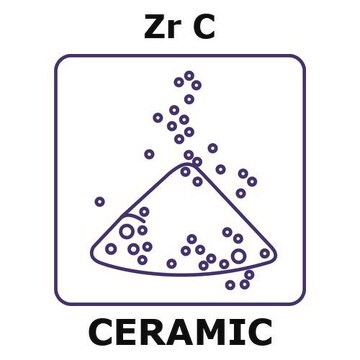267651
Zirconium
sponge, ≥99% trace metals basis
Synonym(s):
Zirconium element
Sign Into View Organizational & Contract Pricing
All Photos(2)
About This Item
Empirical Formula (Hill Notation):
Zr
CAS Number:
Molecular Weight:
91.22
EC Number:
MDL number:
UNSPSC Code:
12141751
PubChem Substance ID:
NACRES:
NA.23
Recommended Products
Assay
≥99% trace metals basis
form
sponge
resistivity
40 μΩ-cm, 20°C
bp
4377 °C (lit.)
mp
1852 °C (lit.)
density
6.5 g/mL at 25 °C (lit.)
SMILES string
[Zr]
InChI
1S/Zr
InChI key
QCWXUUIWCKQGHC-UHFFFAOYSA-N
Looking for similar products? Visit Product Comparison Guide
Application
Starting material for a thermite reaction synthesis of a new compound, ZrXFe1-XO2, which is the first reported example of a compound containing a direct Fe-Zr bond.
Signal Word
Danger
Hazard Statements
Precautionary Statements
Hazard Classifications
Pyr. Sol. 1 - Water-react 1
Supplementary Hazards
Storage Class Code
4.2 - Pyrophoric and self-heating hazardous materials
WGK
WGK 1
Flash Point(F)
Not applicable
Flash Point(C)
Not applicable
Personal Protective Equipment
dust mask type N95 (US), Eyeshields, Gloves
Choose from one of the most recent versions:
Already Own This Product?
Find documentation for the products that you have recently purchased in the Document Library.
Ghigna, P. et al.
Journal of the American Chemical Society, 121, 301-301 (1999)
The enigma of the bilayered zirconia restoration.
Bernard E Keough et al.
Dentistry today, 32(5), 68-68 (2013-06-01)
Gopalu Karunakaran et al.
Journal of nanoscience and nanotechnology, 13(1), 678-685 (2013-05-08)
Currently, nanometal oxides are used extensively in different industries such as medicine, cosmetics and food. The increased consumption of nanoparticles (NPs) leads the necessity to understand the fate of the nanoparticles in the environment. The present study focused on the
M Sasse et al.
International journal of computerized dentistry, 16(2), 109-118 (2013-08-13)
This study evaluated the clinical outcome of CAD/CAM zirconia-ceramic resin-bonded fixed dental prostheses (RBFDPs) with a cantilevered single-retainer design. Thirty anterior zirconia-ceramic RBFDPs fabricated with the Cerec CAD/CAM system were inserted using either a phosphate monomer containing resin (Panavia 21
O Tymofiyeva et al.
Dento maxillo facial radiology, 42(6), 20120271-20120271 (2013-04-24)
To investigate the potential influence of standard dental materials on dental MRI (dMRI) by estimating the magnetic susceptibility with the help of the MRI-based geometric distortion method and to classify the materials from the standpoint of dMRI. A series of
Our team of scientists has experience in all areas of research including Life Science, Material Science, Chemical Synthesis, Chromatography, Analytical and many others.
Contact Technical Service









